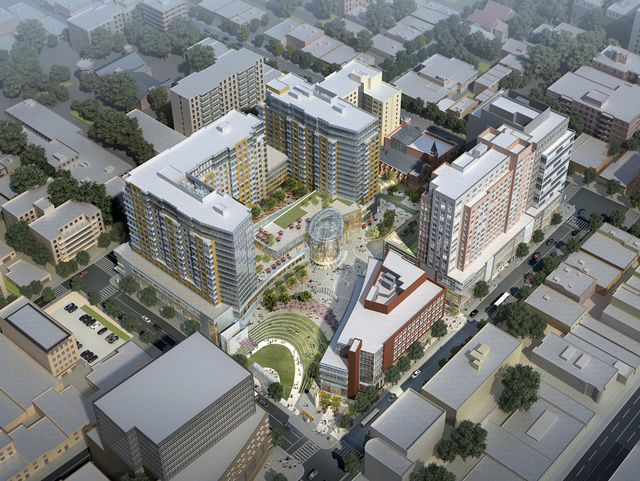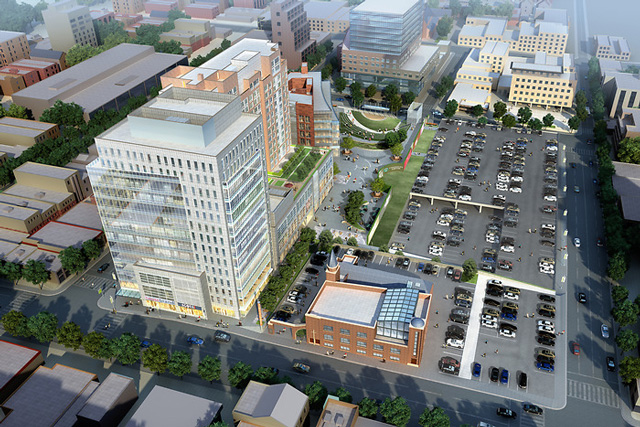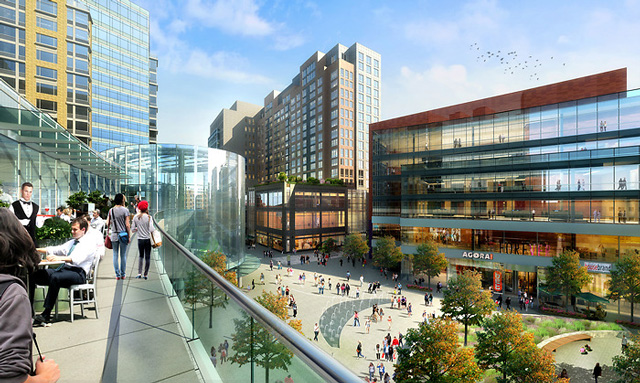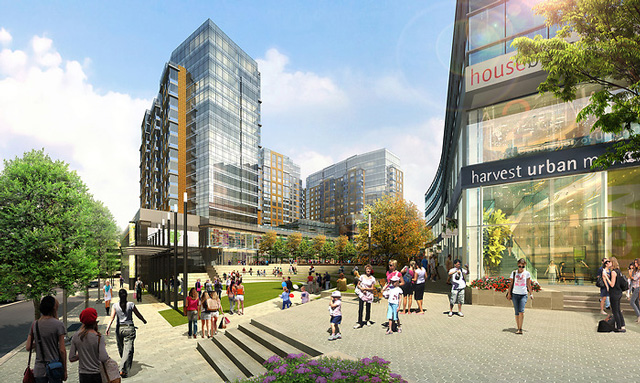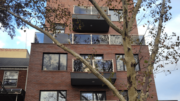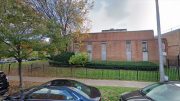About ten miles east of Grand Central Terminal, the 7 train terminates at Flushing Main Street. Stepping out into downtown Flushing, one is immediately struck with a sense of vibrancy, by the tangible energy of entrepreneurial activity. Flushing is home to over 5,000 businesses and 41,000 jobs, putting it right up there with Downtown Brooklyn and Long Island City as one of the city’s most important outer borough business districts.
Like Downtown Brooklyn and Long Island City, downtown Flushing – which vies with Sunset Park for the title of New York City’s most populous Chinese neighborhood – is brimming with potential for new businesses and job growth. The business district is getting a boost with the construction of Flushing Commons, a mixed-use project rising on a former municipal parking lot.
The first phase of this project will include 150 apartments and, notably, 220,000 square feet of commercial space, mostly offices. The second phase will add another 450 units of housing and an additional 150,000 square feet of office space, making Flushing Commons one of the largest new commercial projects in the outer boroughs.
Just how deep does Flushing’s potential for new office space run? YIMBY spoke with Michael Meyer, president of F&T Group, whose subsidiary TDC Development is leading the Flushing Commons development team.
F&T has been one of Flushing’s most active developers. Their Queens Crossing project, completed in 2007, included 210,000 square feet of office space, and they’re also working on One Fulton Square, another mixed-use mid-rise in downtown Flushing.
Right now the office market in Flushing is dominated by medical tenants, with Meyer estimating that 80 percent of Queens Crossing commercial tenants are medical users. “Most of the space we have here is office condominium,” Meyer said. “Our office building in Flushing Commons will be condo, and One Fulton Square, hitting the market now, is office condo. Those are predominantly sold to doctors, and they’re predominately sold to Chinese and Asian doctors,” with Flushing also being a major hub for New York City’s Korean community.
“Right now you don’t have any large corporate entities that would be behind a lot of office growth,” said Meyer. “You don’t have the large blocks of office space I think you’re going to need, like how Jet Blue went over to Long Island City. Nobody is going to build it on spec,” he said, unless a corporate tenant is lined up. “There’s so much interest in investing in Flushing from Asia, from mainland China, South Korea, Taiwan. Maybe it would take a large corporation from there.”
Meyer believes that Willets Point would have been an ideal location to attract this type of tenant. F&T was among the developers to submit a proposal for Willets Point, but the city ultimately chose Related Companies and Sterling to develop the site.
F&T’s proposal included a pedestrian bridge linking Willets Point to a reactivated Flushing waterfront. The bridge would not only have been an iconic structure, but sought to “link and expand the development zone and create a nexus in this area.”
“Looking forward, there could still be elements of that kind of thinking,” Meyer says. He thinks that the city should look at the Flushing waterfront as an area to be rezoned for “more enlightened, urban development.”
The area on the western edge of Flushing, on the waterfront across from Willets Point, was rezoned over a decade ago, but “that zoning wasn’t ideal for redevelopment from an urban standpoint,” Meyer says. “It was really more suburban, particularly because of the parking requirements.”
Meyer believes a rezoning effort along with a new park and waterfront esplanade would unleash a torrent of new development.
“If you could get the state, city and federal governments coordinated on cleaning up the creek and doing some infrastructure development there – like a pedestrian bridge – you would totally transform the area. That would allow extraordinary, extraordinary development and have an effect for generations.”
Meyer also thinks that providing incubator space for startups could ultimately lead to more commercial growth. “When we start talking about Flushing, because of the very entrepreneurial populace here, there’s an opportunity to incubate future office demand by doing initiatives like that. If you started small and it attracted foreign venture capital it could result in more robust commercial growth, and that’s something that would sit well with the population here.”
Parking requirements and suburban-style zoning are hurting the prospect of new development along the Flushing waterfront. In fact, city parking requirements nearly derailed the Flushing Commons development. He notes that because of pressure from the local community – shopkeepers, residents, and elected officials – Flushing Commons will have twice as much parking as would have been required under zoning.
“We prevailed at Flushing Commons, but we almost died because of the bias for parking. A huge threat to enlightened development is the attitude that people have towards parking and the misconceptions people have about parking, which is unfortunately enabled by local politicians who sort of support it.”
“If you didn’t have to worry about politics and you were trying to design a development in a congested area, you would come up with a traffic and urban and zoning plan that would not build so much parking.”
Meyer said that the Flushing Commons took so long to break ground because of the process of incorporating community benefits, but ultimately the idea of community benefits is valid.
“Getting all that to work,” including the parking, “was extraordinarily challenging.”
“I do think it is legitimate for community benefits to be introduced in developments where there is some sort of city subsidy, on city land. I think the political process by which that works is often counterproductive, and winds up making a lot of development expensive or unfeasible. Or it imposes such a burden that the development you ultimately get maybe isn’t the best for the neighborhood.”
Talk about this topic on the YIMBY Forums
For any questions, comments, or feedback, email [email protected]
Subscribe to YIMBY’s daily e-mail
Follow YIMBYgram for real-time photo updates
Like YIMBY on Facebook
Follow YIMBY’s Twitter for the latest in YIMBYnews

